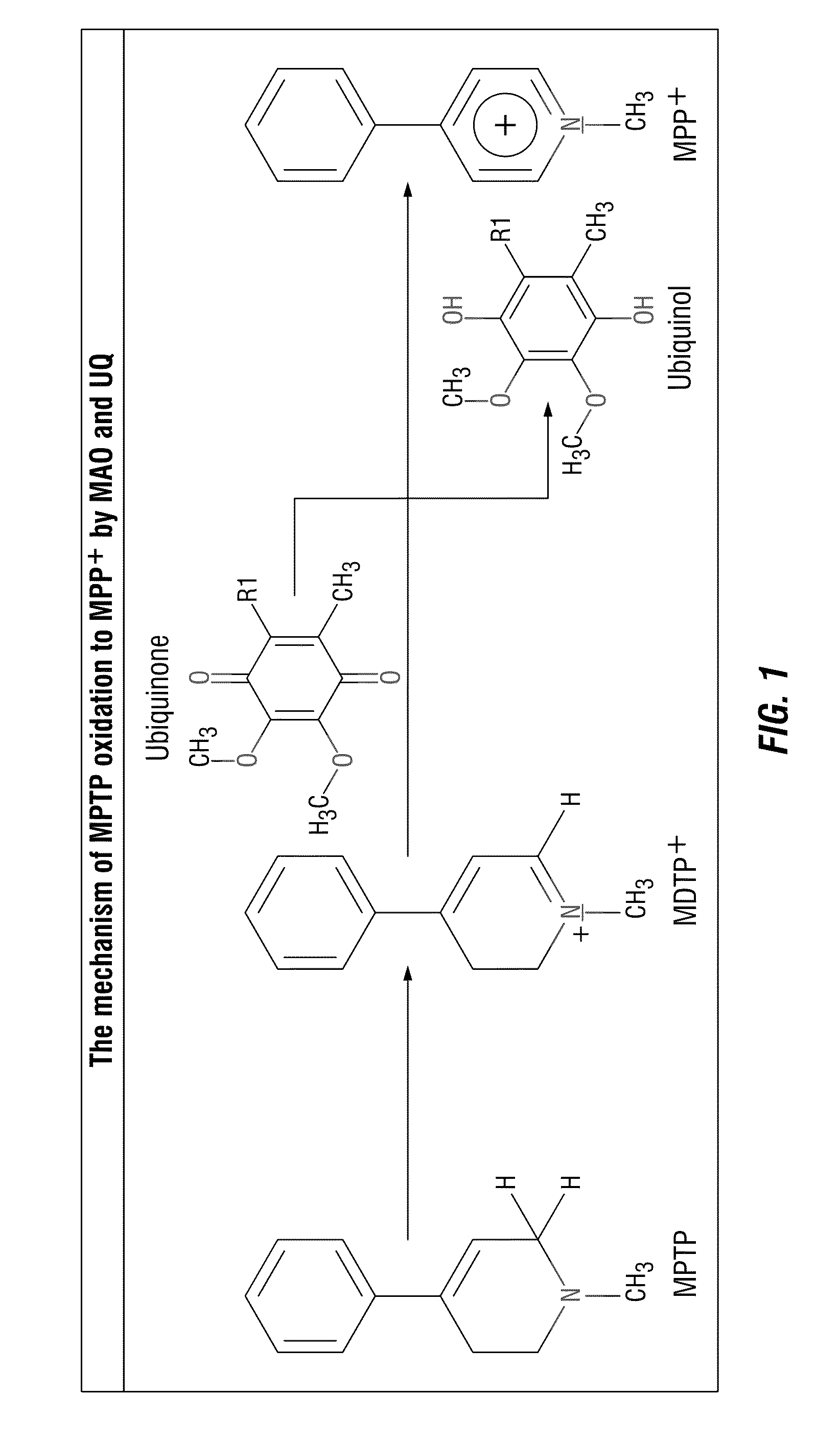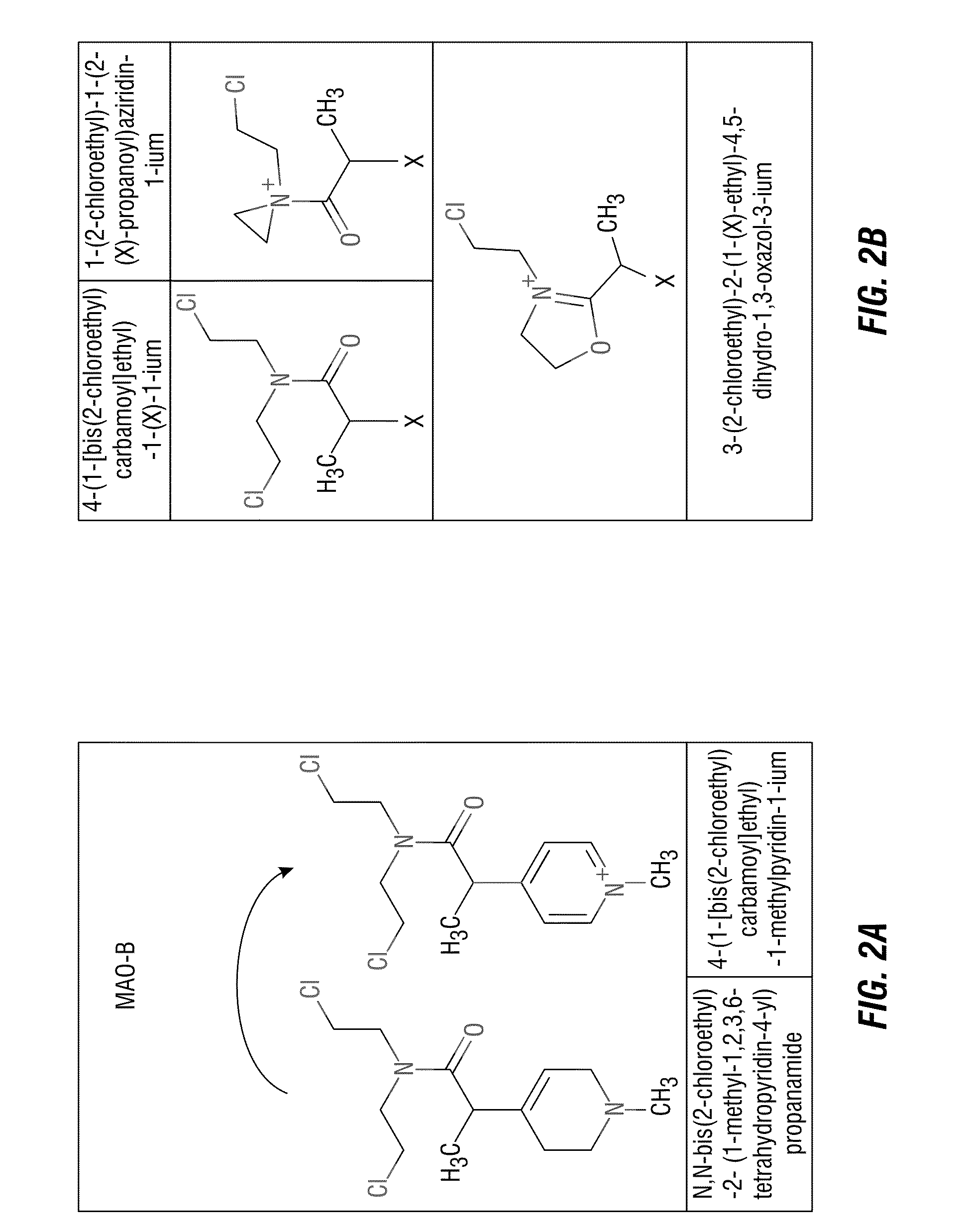Chemotherapeutic Compositions and Methods for Treating Human Gliomas
a composition and composition technology, applied in the field of chemotherapeutic compositions and oncological treatment methods, can solve the problems of poor prognosis of high-grade gliomas, limited success to date, and anaplasticity of high-grade gliomas, so as to facilitate the conversion of pro-drug, prevent, and/or amelio
- Summary
- Abstract
- Description
- Claims
- Application Information
AI Technical Summary
Benefits of technology
Problems solved by technology
Method used
Image
Examples
example 1
Glioma-Specific Drug Design (1)
[0210]Using the aforementioned criteria, the inventors have designed and synthesized a novel pro-drug, the activated form of which has specifically designed to kill mammalian gliomas. This pro-drug, designated MP-MUS (I), is activated by mammalian MAO-B enzyme to form P+-MUS (I), an acylation agent, whose ionic charge and inherent lipophilicity results in mitochondrial accumulation of the agent. This compound has been successfully tested in primary human glioblastoma cells, and shown to possess potent anti-cancer properties in vivo.
[0211]MP-MUS (I) is a Mitochondrial-Specific “Smart Bomb”
[0212]Design of a MAO-B Specific “Warhead” Compound.
[0213]The MAO-B-mediated conversion of the 1-methyl-1,2,3,6-tetrahydropyridine moiety into a 1-methyl-pyridium cation facilitates mitochondrial targeting of the novel therapeutics described herein (FIG. 1).
[0214]The “warhead” of this “smart-bomb” chemotherapeutic is nitrogen mustard, which has been used in the treatme...
example 2
Glioma-Specific Drug Design (2)
[0228]APE-SN38, a Topoisomerase-Specific “Smart Bomb” for Cancer Treatment.
[0229]Albers and co-workers (2007) demonstrated that aminopropyl ethers were labile in the presence of MAO, and it is this property that led to the development of a novel MAO-A / MAO-B assay system. 7-(3-aminopropoxy)-3H-phenoxazin-3-one is oxidized by MAO (via iminium and aldehyde intermediates), to release the fluorescent compound, resorufin, and propanal via a β-elimination reaction (FIG. 10). Utilizing the same iminium and aldehyde intermediates, followed by a β-elimination reaction, it should therefore be possible to convert existing pharmaceutical compounds having a tertiary / phenolic alcohol group into MAO-specific biotransformable drugs. For example, SN38 is the active metabolite of the pro-drug, camptothecin, and chemotherapeutic, irinotecan (Yao et al., 2011). To demonstrate the facility of utilizing extant therapeutic compounds having tertiary / phenolic alcohol groups in ...
example 3
Killing Primary Human GBM Cells in Vitro Using MP-MUS(I)
[0262]1) Effect of MP-MUS (I) on Cell Growth and Mitochondria.
[0263]Primary glioma human cells, (internally coded as “BT-111”), were obtained for a (first) resection of a Glioblastoma multiforme tumor, and grown in either 96-well microplate format or in slide tanks Cells were incubated with three different drugs; the traditional treatment; temozolomide, nitrogen mustard, or MP-MUS (I). The effects on cell growth and mitochondrial function are shown in FIG. 13A and FIG. 13B in the presence of MP-MUS (I), the parental mustard and Temozolomide in primary GBM cells; BT-111. These results demonstrate that MP-MUS (I) was a potent glioma toxin, with an LD50 5-fold lower than the standard chemotherapeutic drug, temozolomide. Of particular interest was the differing effect observed on mitochondria for these two compounds. MP-MUS (I) abolished half of the mitochondrial complex activity at concentrations of ≈2 μM, whereas temozolomide cau...
PUM
| Property | Measurement | Unit |
|---|---|---|
| Time | aaaaa | aaaaa |
| Electrical resistance | aaaaa | aaaaa |
| Therapeutic | aaaaa | aaaaa |
Abstract
Description
Claims
Application Information
 Login to View More
Login to View More - R&D
- Intellectual Property
- Life Sciences
- Materials
- Tech Scout
- Unparalleled Data Quality
- Higher Quality Content
- 60% Fewer Hallucinations
Browse by: Latest US Patents, China's latest patents, Technical Efficacy Thesaurus, Application Domain, Technology Topic, Popular Technical Reports.
© 2025 PatSnap. All rights reserved.Legal|Privacy policy|Modern Slavery Act Transparency Statement|Sitemap|About US| Contact US: help@patsnap.com



